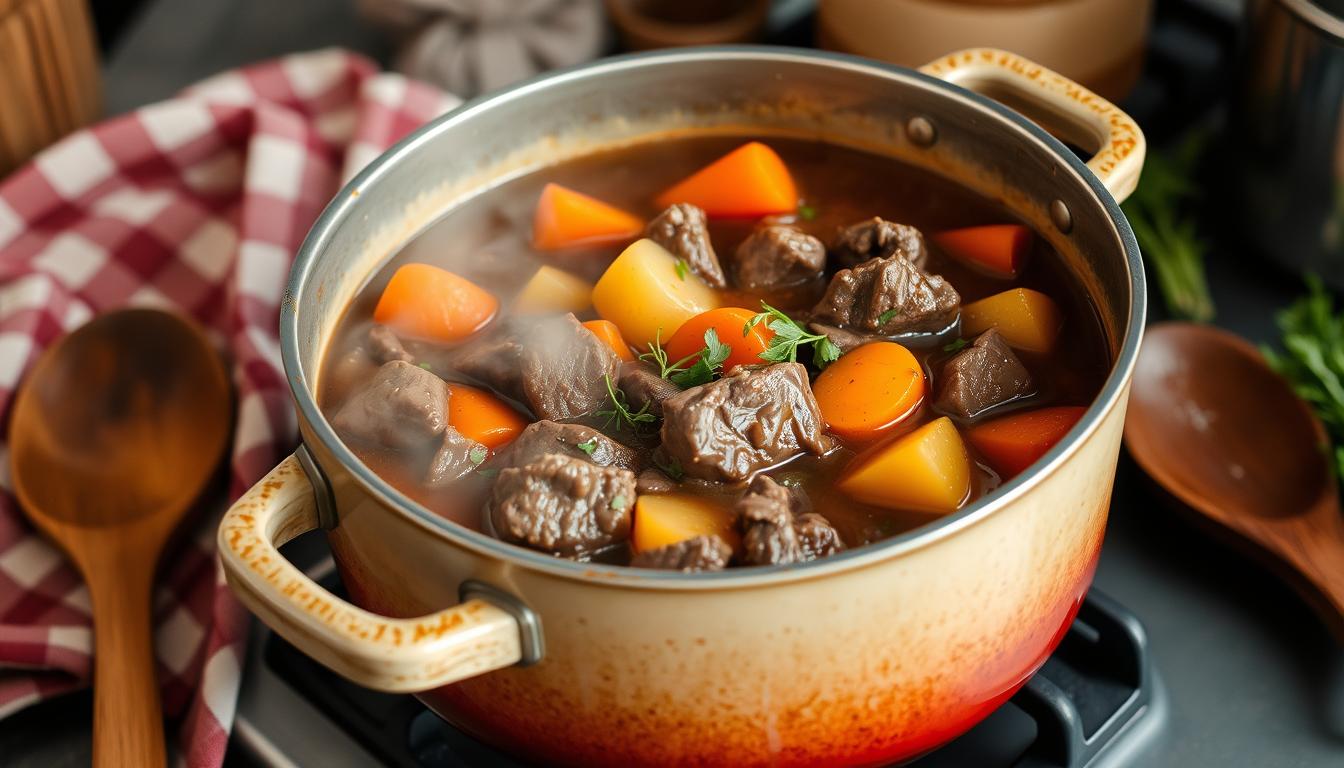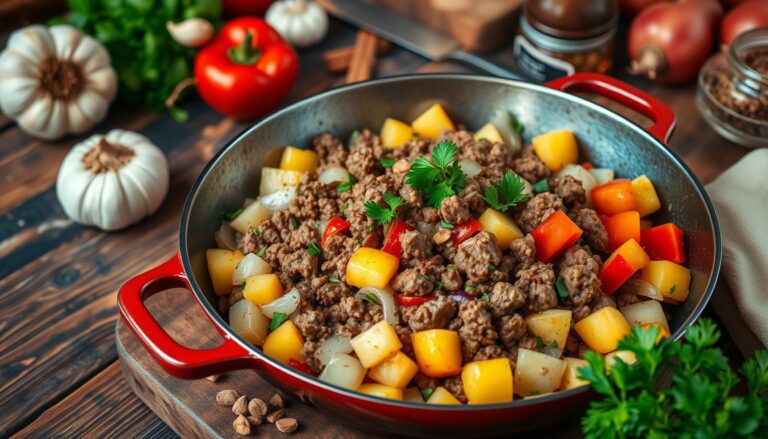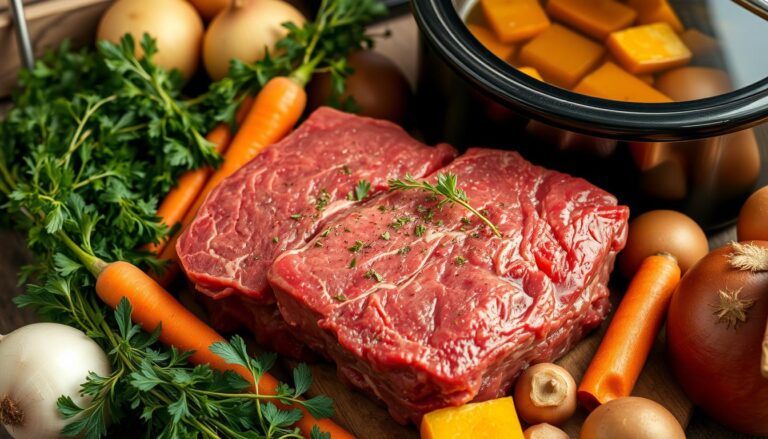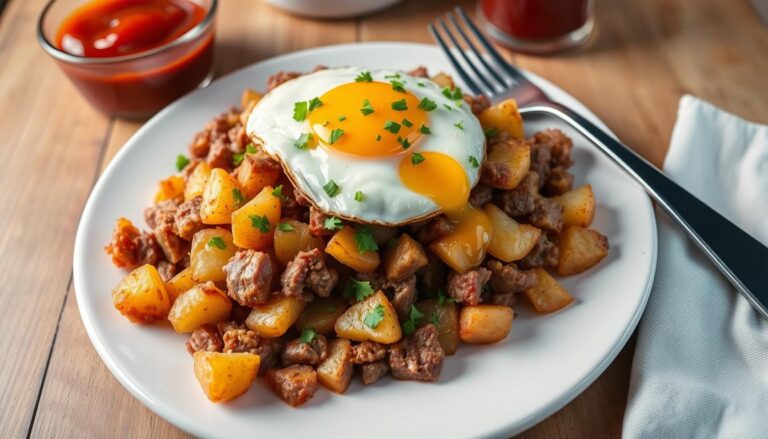Hearty Stove Top Beef Stew Recipe in Under an Hour
Winter nights always remind me of my grandmother’s kitchen. The smell of a stove top beef stew recipe filled every corner with warmth. Growing up, I saw her turn simple ingredients into a magical dish. This dish could heal souls and bring families together in just under an hour.
This is more than just a meal—it’s a quick solution for busy cooks. It offers traditional flavors without hours of cooking. Whether you’re a working pro or a home cook, this recipe is your comfort food.
Table of Contents
Why This Classic Beef Stew is Perfect for Any Season
Your search for the ultimate comfort food ends with an easy stovetop beef stew. It turns simple ingredients into a memorable meal. This dish is both traditional and modern, perfect for busy cooks.
A beef stew in a pot is more than a meal. It’s a way to connect with your family’s past. It’s adaptable for any season and suits many diets.
Traditional Comfort Food Appeal
Home cooks love dishes that warm the heart and bring back memories. A well-made beef stew reminds us of family times and cozy kitchen moments.
- Satisfies deep comfort food cravings
- Creates instant warmth during cold evenings
- Provides a hearty, nutritious meal
Time-Saving Benefits
Your busy life needs quick cooking solutions. An easy stovetop beef stew offers great taste with little prep time. By simplifying cooking, you can enjoy a fancy meal without spending hours in the kitchen.
| Cooking Method | Total Time | Effort Level |
|---|---|---|
| Traditional Slow Cooker | 6-8 hours | Low |
| Stovetop Beef Stew | 1-2 hours | Moderate |
One-Pot Meal Convenience
Using a single pot saves time and makes cleanup easy. This method lets flavors meld, making a restaurant-quality meal at home.
“A great stew is like a warm hug for your taste buds – comforting, satisfying, and always welcome.”
Essential Ingredients for Stove Top Beef Stew Recipe
To make a tasty stew on the stove, you need the right ingredients. They should add flavor and make the meat tender. Choosing the best ingredients is key to a great beef stew.
For a top-notch beef stew with frozen veggies, start with these essential items:
- 2 pounds chuck roast, cut into 1-inch cubes
- 2 tablespoons all-purpose flour for coating meat
- 1 large sweet onion, chopped
- 2 large carrots, sliced
- 1 pound fingerling or small red potatoes
Seasoning is important to enhance the stew’s taste:
- 2 teaspoons herbes de Provence
- 3/4 teaspoon kosher salt
- 1/2 teaspoon freshly ground black pepper
- 1/2 teaspoon garlic powder
Liquids add depth to the stew:
| Ingredient | Quantity |
|---|---|
| Beef Broth | 3 cups boiling water |
| Beef Base | 3 tablespoons Better Than Bouillon |
| Tomato Paste | 3 tablespoons |
| Frozen Peas | 1 cup (added at end) |
“The secret to a perfect stew is balance – each ingredient should complement the others without overpowering.” – Professional Chef
Remember, quality ingredients are crucial for a meal that warms your heart and soul.
Selecting and Preparing the Perfect Cut of Beef
Making a great beef stew begins with picking the right meat. The right cuts turn tough into tender during cooking. Knowing how long to cook stew beef is key to a delicious dish.
Best Cuts for Stewing
For a top-notch beef stew, choose these cuts:
- Chuck roast – A top choice for its rich flavor
- Bottom round – Lean and budget-friendly
- Brisket – Provides deep, meaty taste
- Cross-cut shanks – Perfect for developing rich flavor
Proper Cutting Techniques
To cook stew meat well, cut it evenly. Precision is key. Cut your beef into 1-inch cubes for even cooking and tender results. Larger pieces take longer to soften, while smaller ones might dry out.
“The secret to a perfect stew is in the cut and preparation of the meat.” – Chef’s Wisdom
Seasoning Methods
Season your meat well before cooking. Salt and pepper are a great start. For more flavor, add herbs like thyme or rosemary.
| Beef Cut | Cooking Time | Recommended Technique |
|---|---|---|
| Chuck Roast | 2-3 hours | Slow cooking |
| Bottom Round | 1.5-2 hours | Low and slow |
| Brisket | 3-4 hours | Braising |
Patience is crucial when making the perfect beef stew. Take your time to choose, cut, and season your meat carefully.
Kitchen Tools and Equipment Needed
To make a tasty beef stew on the stovetop, you need the right tools. Your main tool will be a large Dutch oven or heavy-bottomed pot. These are key for a great beef stew dutch oven stovetop experience.
- Large Dutch oven or heavy-bottomed pot
- Sharp chef’s knife for meat and vegetable prep
- Cutting board
- Measuring cups and spoons
- Wooden spoon for stirring
- Tongs for handling meat
Choose a Dutch oven with even heat distribution. Cast iron is great for stovetop beef stew. It keeps heat well and adds deep flavors.
“The right tools can transform a good beef stew into an extraordinary meal.”
Optional tools include a garlic press, vegetable peeler, and a meat thermometer. These help ensure perfect doneness. Your Dutch oven will make a convenient and tasty one-pot meal.
Step-by-Step Cooking Instructions
Learning to cook beef stew in a pot takes patience and skill. Your traditional beef stew recipe on the stove will turn simple ingredients into a delicious, hearty meal. It’s a dish that warms the soul.
Ready to learn how to cook stew meat on the stove? Follow these detailed instructions. Each step adds to the flavor and ensures tender, tasty results.
Preparing the Vegetables
Begin by carefully prepping your vegetables. Chop 1 pound of onions, cut carrots into 1 ½-inch lengths, and clean 1 pound of new potatoes. Aim for uniform pieces for even cooking.
- Peel and dice onions into consistent chunks
- Cut carrots to 1 ½-inch lengths
- Wash and quarter new potatoes
- Mince 6 garlic cloves for added depth
Browning the Meat
Browning is key for rich flavors in your beef stew recipe. Use 3 pounds of beef chuck, cut into 1 ½-inch cubes.
- Pat beef dry with paper towels
- Season with salt and pepper
- Brown in batches using 1 tablespoon olive oil per batch
- Cook 7-8 minutes over medium-high heat
Creating the Perfect Gravy Base
A rich gravy makes your stew truly special. Deglaze the pot with red wine, add tomato paste, and mix in a velvety sauce.
- Use ⅓ cup tomato paste for depth
- Add 2 tablespoons all-purpose flour to thicken
- Pour in 3 cups of water or beef broth
- Simmer with 2 bay leaves for maximum flavor
Pro tip: Let your stew simmer low and slow for 1.5-3 hours until the meat becomes incredibly tender.
Tips for Achieving Tender Meat Every Time
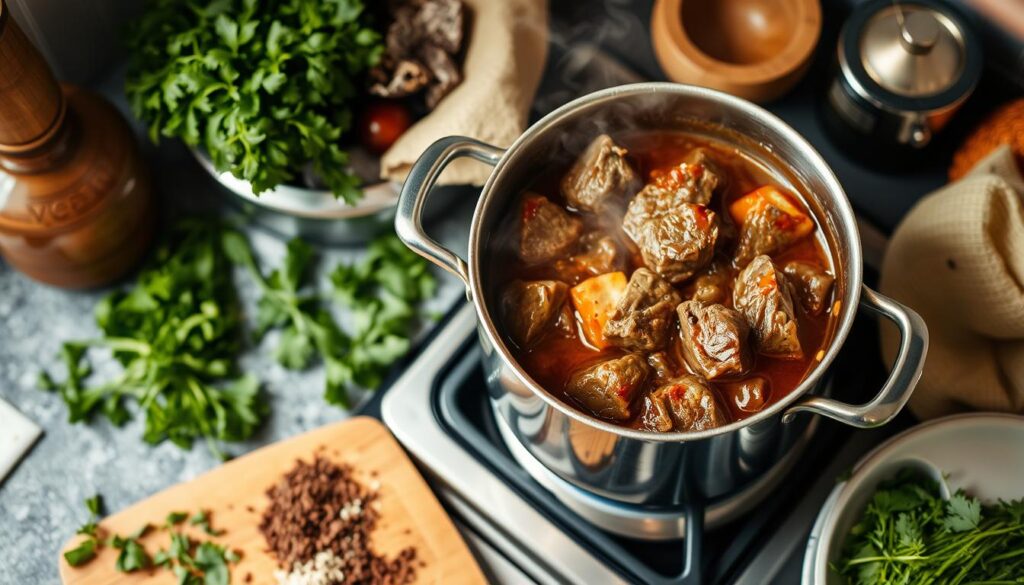
Learning to cook stew meat perfectly can change your cooking game. The key to tender beef is knowing the right techniques and being patient.
When it comes to stewing beef, temperature and method matter a lot. Start by letting the beef come to room temperature for about 30 minutes. This helps prevent dryness and ensures even cooking.
“Great stew is an art of patience and precision” – Culinary Wisdom
- Sear meat before stewing to develop rich flavor
- Maintain low cooking temperatures between 284°F and 320°F
- Keep enough liquid in the pot to prevent meat from drying
- Select tough cuts like chuck or bottom roast for best results
Here are some top methods for tender meat:
| Cooking Method | Duration | Meat Texture |
|---|---|---|
| Gentle Stovetop Simmer | 2.5-4 hours | Extremely Tender |
| Low-Temperature Cooking | 4-6 hours | Fall-Apart Soft |
For even more tenderness, try using vinegar or lemon juice as a tenderizer. Also, coat the beef with 2-3 tablespoons of flour before searing. This will make your stew incredibly tender and flavorful.
Creating Rich and Flavorful Gravy
Making the perfect gravy is key to a great thick beef stew recipe on the stove top. A good gravy can turn a simple meal into a feast.
To make the best beef stew on the stove top, you need to master thickening and seasoning. Let’s explore how to make a gravy that will make your stew unforgettable.
Thickening Techniques for Perfect Consistency
There are a few ways to thicken your stew’s gravy:
- Flour roux: Use about 3 tablespoons of butter and 4 tablespoons of flour
- Cornstarch slurry: Mix 4 tablespoons cornstarch with 1/3 cup water
- Instant potato flakes: A quick and gluten-free choice
Seasoning Balance for Depth of Flavor
Getting the flavor right is important for a great gravy. Here are some seasoning tips:
- Use 1 teaspoon garlic powder
- Add Worcestershire sauce for depth
- Try herbs like thyme and rosemary
Nutritional Insights
| Nutrient | Per Serving |
|---|---|
| Calories | 65 |
| Carbohydrates | 5g |
| Protein | 2g |
| Fat | 5g |
Pro tip: Simmer your gravy for 2-3 minutes after thickening. This will make it even richer.
“The secret to an incredible stew is in the gravy’s complexity and depth.” – Culinary Wisdom
With these tips, you’ll make a gravy that will enhance your beef. Every bite will be a joy.
Vegetable Combinations and Alternatives
Creating a beef stew without carrots opens up a world of tasty vegetable options. Stovetop recipes with stew beef cubes let you get creative with veggies.

Most stews have a mix of veggies, but you can change it up. Here are some great veggie choices to make your beef stew better:
- Root Vegetable Alternatives: Try parsnips or turnips for a different taste
- Green beans or Brussels sprouts add a pop of color
- Seasonal squash is perfect for winter stews
“The secret to a great beef stew is balancing flavors and textures through thoughtful vegetable selection.” – Professional Chef
Here are some veggie mixes that pair well with stew beef cubes:
| Vegetable Category | Recommended Options | Cooking Time Adjustment |
|---|---|---|
| Root Vegetables | Parsnips, Turnips, Rutabagas | Similar to potatoes |
| Green Vegetables | Green Beans, Peas, Spinach | Add in final 15 minutes |
| Winter Squash | Butternut, Acorn Squash | Cut in larger chunks |
When picking veggies for your stew, think about cooking times. Harder veggies like potatoes and parsnips go in early. Delicate greens are best added later. Your beef stew is a blank canvas for your creativity!
Storage and Reheating Guidelines
Keeping your stovetop beef stew tasty involves the right storage and reheating methods. These steps help you enjoy this meal over and over again. You’ll keep the flavors and safety in check.
Proper Cooling and Refrigeration
Let your beef stew cool down completely at room temperature. Don’t put hot stew straight into the fridge. This can lead to bacterial growth and is unsafe.
- Cool stew within 2 hours of cooking
- Use shallow, airtight containers
- Refrigerate for up to 3-4 days
Freezing Your Beef Stew
Freezing is a great way to keep your beef stew fresh longer. The right packaging is crucial for keeping flavors and textures intact.
| Freezing Method | Details |
|---|---|
| Storage Container | Airtight, freezer-safe container |
| Maximum Storage Time | Up to 3 months |
| Thawing Method | Overnight refrigeration |
Reheating Tips
Reheating your beef stew gently is key to keeping its flavors and meat tender. Avoid high heat, which can toughen the meat and dry out the vegetables.
- Use low to medium heat on stovetop
- Stir occasionally to prevent scorching
- Add a splash of broth if stew seems dry
- Heat until internal temperature reaches 165°F
Pro tip: A slow, gentle reheat maintains the stew’s original mouthwatering texture and taste.
Serving Suggestions and Pairings
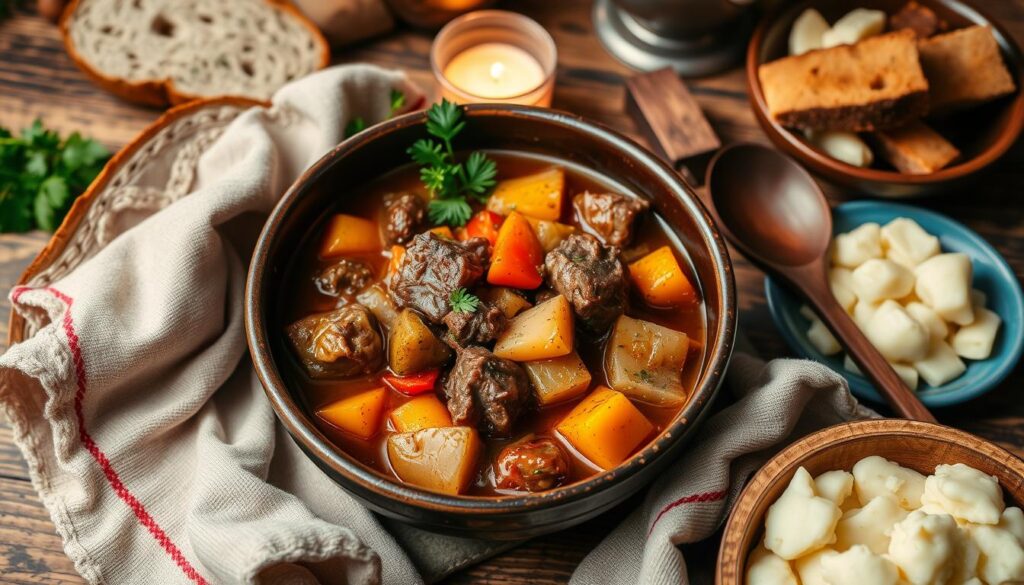
Your delicious steak stew recipe deserves the perfect accompaniments. These can make your meal unforgettable. Focus on sides that bring out the stew’s rich flavors.
Classic Serving Recommendations
Here are some tasty options for your easy steak stew:
- Creamy mashed potatoes
- Crusty artisan bread
- Roasted Brussels sprouts
- Crunchy side salad
- Warm cornbread muffins
Wine and Beverage Pairings
Choose the right wine to match your stew’s bold flavors. Here are some top picks:
- Cabernet Sauvignon: Bold tannins with dark fruit notes
- Syrah/Shiraz: Peppery flavor with dark berry undertones
“A great stew is about balance and harmony on the plate.” – Chef’s Wisdom
Pro Serving Tips
For a stunning presentation, top your stew with fresh parsley. Serve it in deep, warmed bowls. Stews taste even better when made a day ahead, letting flavors mature.
| Side Dish | Preparation Time |
|---|---|
| Cornbread Muffins | 30 Minutes |
| Roasted Brussels Sprouts | 25 Minutes |
Try these serving tips to make your easy steak stew recipe unforgettable. It will surely impress your family and friends.
Troubleshooting Common Stew Problems
When making stew beef cubes recipes, even the best cooks face issues. Knowing how to fix these problems can turn a bad meal into a great one.
Tough meat is a common problem in beef stew. The secret to tender meat is in the cooking method. Your stew beef cubes need enough time and moisture to soften.
- Cooking Time: If meat is still tough, cook it for 30-45 minutes longer
- Use low, steady heat to help meat become tender
- Check internal temperature – beef should reach 160°F
Thin gravy can mess up your stew’s texture. But, there are easy ways to thicken your sauce:
- Mix ¼ cup all-purpose flour with ¼ cup cold water
- Whisk mixture into hot stew
- For gluten-free options, use 2 tablespoons cornstarch
| Problem | Solution |
|---|---|
| Bland Flavor | Add fresh herbs, extra seasoning, or a splash of red wine |
| Vegetables Too Soft | Add vegetables later in cooking process |
| Lack of Depth | Use beef broth instead of water |
Pro tip: Patience is the secret ingredient in creating the perfect stew.
With these tips, you’ll get better at making stew beef cubes recipes. You’ll create unforgettable meals every time.
Conclusion
Your journey to mastering the stove top beef stew recipe is now complete. This dish is more than just a meal. It’s a culinary adventure that turns simple ingredients into a rich, comforting experience. You can now make a stew that rivals restaurant-quality meals in your own kitchen.
Remember, each stove top beef stew recipe is a chance for personal creativity. The dish’s beauty lies in its adaptability. You can try different vegetables, swap proteins, or adjust seasonings to fit your family’s taste. The techniques you’ve learned will guide you to delicious variations.
Whether it’s for a weeknight dinner or a special meal, your skills will ensure a hearty, flavorful stew. Don’t be afraid to make this recipe your own. With practice, you’ll get better at balancing flavors, tenderizing meat, and making that perfect, rich gravy that makes a stew unforgettable.
Your culinary confidence has grown. Now, it’s time to head to the kitchen and cook a stew that will warm hearts and create lasting memories. Bon appétit!

